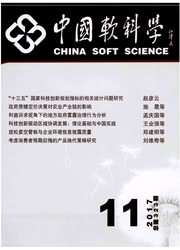

 中文摘要:
中文摘要:
本文首先比较了我国与美国、欧盟、日本在部门能源强度和产业结构上的差距,进而利用Markov模型对未来我国产业结构进行预测,在此基础上分析了我国未来能源强度的走势以及产业结构演变对降低能源强度的贡献。比较发现,我国各部门能源强度显著高于美国、欧盟和日本,且第一和第二产业比重过高和第三产业过低的产业结构均造成我国碳排放居高的现状。与美欧日相比,我国降低能源强度的减排潜力分别为24%、60%和53%;产业结构演变的减排潜力分别为40%、32%和28%。未来我国第一产业比重将持续下降近4个百分点,第二产业比重小幅下调1.5个百分点,第三产业比重明显上升5.3个百分点。但是各产业比重变动幅度到后期变慢,趋于稳定,产业结构演变对能源强度贡献越来越小。2020年和2030年我国能源强度将比2007年分别降低52.2%和68.9%,相应产业结构演变的贡献度从15.44%下降到7.86%。
 英文摘要:
英文摘要:
This paper firstly compared the energy intensity of economic sectors and industrial structures among China, U- nited States, European Union and Japan. And then we projected the evolution of industrial structure, based on which the future trajectory of energy intensity of China is analyzed, as well with the contribution of industrial structure evolution on the decrease of energy intensity. By comparison, we found the energy intensity of almost all sectors is significantly higher than that of US, EU and Japan, which in conjunction with the overweighted shares of primary and secondary industry caused the high carbon emission of China. The abatement potential are 24% ,60% and 53% by dropping the sectoral energy intensity of China to the level of US,EU and Japan; while they are 40% ,32% and 28% if the industrial struc- ture of China is the same as that of US, EU and Japan. Our projection on industrial structure evolution indicated that theshare of primary industry will continue to decrease by nearly 4 percentage point through 2030,relative to that of 2010; the share of secondary industry will adjust downward by 1.5 percentage point and that of tertiary industry will rise by 5.3 percentage point simultaneously. However, the step of evolution tends to be slowing down and the whole process of evolu- tion is stabilizing. Consequently,the energy intensity of the society at large will decline by 52. 2% and 68.9% by 2020 and 2030 compared to the level of 2007 ; and the contribution of industrial structure evolution drops from 15.44% to 7. 86%.
 同期刊论文项目
同期刊论文项目
 同项目期刊论文
同项目期刊论文
 An Optimal Balanced Economic Growth and Abatement Pathway for China under the Carbon Emissions Budge
An Optimal Balanced Economic Growth and Abatement Pathway for China under the Carbon Emissions Budge Carbon emissions trends with optimal balanced economic growth of China and the USA and some abatemen
Carbon emissions trends with optimal balanced economic growth of China and the USA and some abatemen 期刊信息
期刊信息
